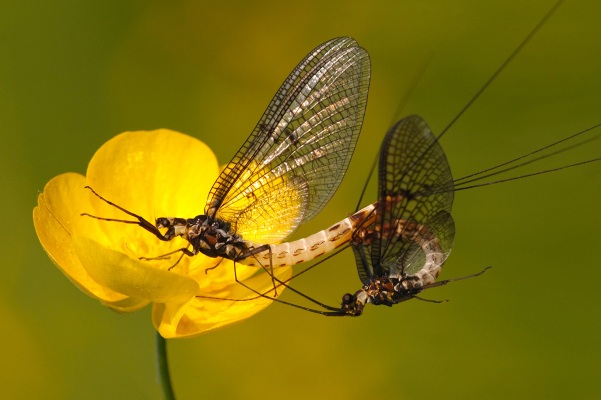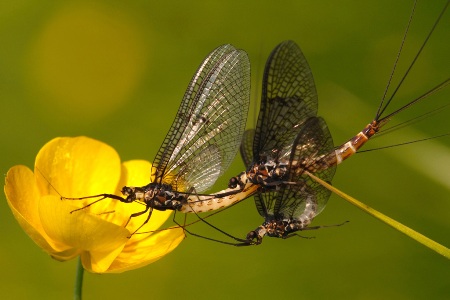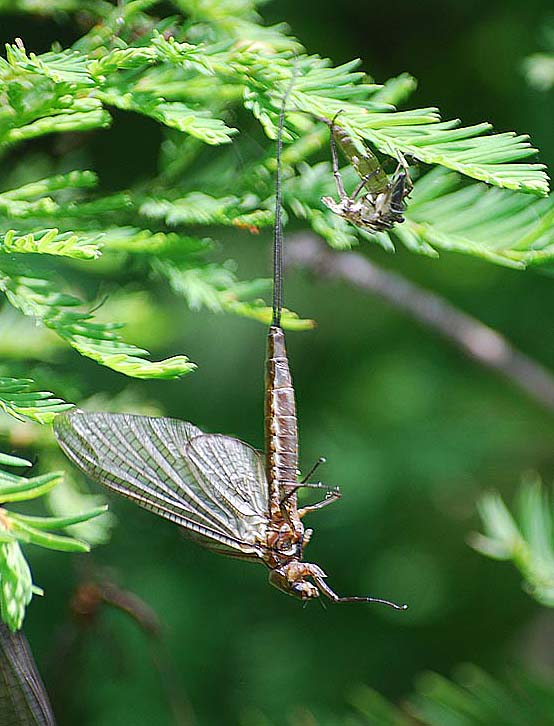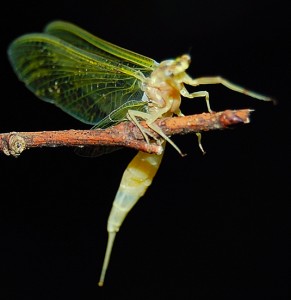
Reproduction
Mating of adult mayflies usually takes place shortly after
the final molt and in the majority of species is followed sh ortly by death. The time of death after
mating may vary,
for example males and females of the Hexagenia genus
may live long enough to mate on two successive days, whereas
mayflies of the Tricorythodes last only four to five
hours(Leonard,1962).
ortly by death. The time of death after
mating may vary,
for example males and females of the Hexagenia genus
may live long enough to mate on two successive days, whereas
mayflies of the Tricorythodes last only four to five
hours(Leonard,1962).
Mating is preceded by
a male mating flight in the late afternoon or early evening.
Males fly upward and forward for a short distance and then down
towards the surface of the water. When the females join in the
males approach them from below and grab on around the female
thorax using their elongated legs. The two fly up and down
until the mating act is complete, the female is let go of by the
male to go lay her eggs and die. Actual mating is not as
well coordinated as all of this makes it sound, the act of
mating for mayflies takes place in large numbers and is
a sight to
 see. Dispersal of eggs may
fall
under four categories depending on the species. One way is
for the female to drop her eggs from paired oviducts in two long
packets from around her foot in the air. In another method
the eggs are protruded in a rounded mass several feet up in the
air in a dive bombing mode of flight. A third mechanism
for egg dispersal occurs when the female flies low to the water
surface, bumping her abdomen on the water several times
releasing a couple eggs each time, and the fourth way the female
mayfly may disperse her eggs is by crawling underwater on a
submerged object and releasing the eggs while submerged. Once they
eggs are released, the mayfly life cycle is under way.
see. Dispersal of eggs may
fall
under four categories depending on the species. One way is
for the female to drop her eggs from paired oviducts in two long
packets from around her foot in the air. In another method
the eggs are protruded in a rounded mass several feet up in the
air in a dive bombing mode of flight. A third mechanism
for egg dispersal occurs when the female flies low to the water
surface, bumping her abdomen on the water several times
releasing a couple eggs each time, and the fourth way the female
mayfly may disperse her eggs is by crawling underwater on a
submerged object and releasing the eggs while submerged. Once they
eggs are released, the mayfly life cycle is under way.
Mayfly Lif e Cycle
e Cycle
The mayfly life cycle consists of four life stages: egg,
nymph, subimago, and imago (adult) which is the form people are
most familiar with. Eggs are laid by the female and vary
in size, shape and number. They can be ellipsoid, ovoid,
or rounded, and can range in width from 0.03 mm to 0.07 mm
(Leonard, 1962). In terms of numbers, a female can lay up
to around 7,500 eggs with an average of 4,000 (Leonard, 1962).
The eggs are released into the water where they
either stick to the bottom of the lake or attach to an object on the way
down. Hatching (after about two weeks) gives rise to the
nymph stage of the life cycle. The nymph lives under water
until it is fully grown and recognizable as an insect with three
pairs of jointed appendages attached under the thorax.
Once this growth is complete, the nymphal skin splits (growth
via molting which is characteristic of arthropods) and the subimago (winged form) emerges. The subimago
then flies from the water surface to a sheltered area where it will
rest and eventually molt for the final time into the imago (adult)
life stage. Duration between the subimago and imago stages
varies depending on the species and can be affect by weather. Here is an excellent
video showing the complete life cycle of these flies.
Now that you have an idea about the mayfly life cycle and how they
reproduce check out the interactions
page to see what other kinds of organisms these creatures have an
impact on!
complete, the nymphal skin splits (growth
via molting which is characteristic of arthropods) and the subimago (winged form) emerges. The subimago
then flies from the water surface to a sheltered area where it will
rest and eventually molt for the final time into the imago (adult)
life stage. Duration between the subimago and imago stages
varies depending on the species and can be affect by weather. Here is an excellent
video showing the complete life cycle of these flies.
Now that you have an idea about the mayfly life cycle and how they
reproduce check out the interactions
page to see what other kinds of organisms these creatures have an
impact on!
Back to homepage